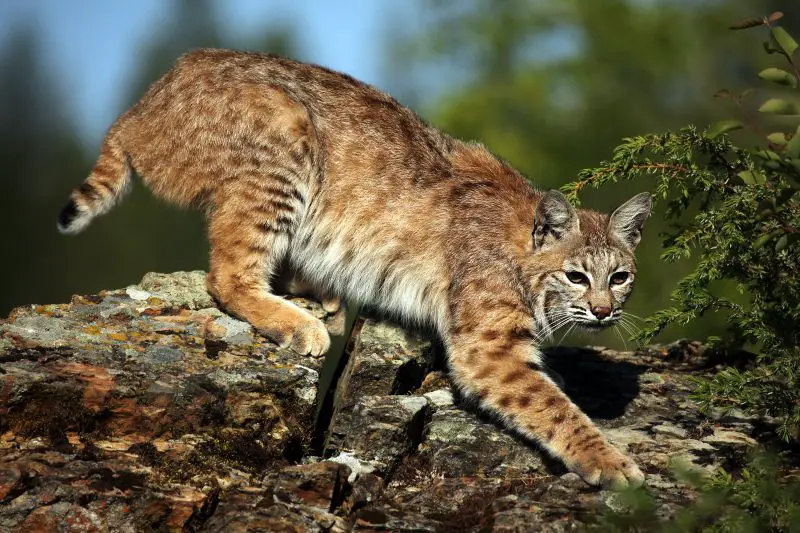Bobcats are one of Montana’s most adaptable wild predators, quietly shaping the balance of ecosystems across forested mountains, rolling prairies, and rugged canyon landscapes. Their presence is often subtle, but the ecological impact they leave behind is far from small. In Montana’s changing seasons, harsh winters, and diverse habitats, bobcats continue to thrive in ways that reveal their resilience and evolutionary precision.
This article explores the most important biological and behavioral facts about bobcats in Montana. Each section breaks down vital aspects of their ecology, diet, reproduction, habitat use, and interactions with humans. The goal is to offer a clear, research-based view while still maintaining a natural, engaging reading experience.
Below are 11 key facts every Montana wildlife enthusiast should know.
1. Bobcats Thrive in Montana’s Diverse Habitats

They adapt to multiple ecosystems
Bobcats in Montana survive in landscapes ranging from timbered foothills to sagebrush flats and river bottoms. Their ability to occupy such distinct habitats shows just how flexible and resilient the species is.
In dense forests, they rely on undergrowth for ambush hunting. In open spaces, they travel through coulees, brush patches, or rocky outcrops that offer cover and vantage points.
Montana’s steep terrain and wide temperature swings are challenges for many mammals, but bobcats adjust by shifting between habitat zones throughout the year. Their versatility is one of the main reasons they remain widespread across the state.
Seasonal changes influence their movements
During summer, bobcats often choose forest edges, riparian corridors, and shaded hillsides. Winter pushes them toward lower elevations where prey remains active and snow levels are manageable.
These shifts create predictable seasonal patterns, but each bobcat still operates within its own unique range, shaped by food availability and competition.
2. Bobcats in Montana Live Solitary Lives
Territorial behavior shapes their daily movements
Bobcats in Montana prefer to live alone except during mating season or when females raise young. Their solitary nature reduces conflict and ensures enough food for each individual.
Adult males maintain the largest ranges, sometimes reaching up to 50 square miles. Females occupy smaller territories centered on reliable prey sources.
Their territories overlap only at the edges. Scent markings, scratches on logs, and scat piles help define boundaries. These natural communication tools prevent unnecessary confrontations.
Territory size depends on prey availability
In rich riparian habitats and foothill woodlands, ranges are smaller because food is more abundant. In harsher regions such as high-elevation slopes, bobcats must roam greater distances to find consistent prey.
This shifting pattern has been well-documented by wildlife biologists studying snow tracks and remote camera data.
3. Bobcats Play an Ecological Role in Montana’s Food Web
They help stabilize small mammal populations
Bobcats keep populations of rabbits, mice, ground squirrels, and other small mammals in check. This reduces agricultural damage and supports overall ecosystem health.
By controlling rodent numbers, they indirectly influence vegetation growth and seed distribution patterns.
Bobcats also reduce mesopredator pressure. When they occupy an area, species like raccoons and skunks experience increased competition, preventing them from overpopulating sensitive habitats.
Their presence indicates healthy landscapes
Consistent bobcat activity often signals a strong prey base and well-balanced habitat structure. Wildlife managers use bobcat observations to help gauge regional ecological health.
4. Bobcats Remain Active Year-Round in Montana
They hunt continuously even in harsh winters
Montana’s winters are demanding, but bobcats do not hibernate. They stay active through snowstorms, freezing temperatures, and reduced prey visibility.
Their thick fur and large paws help insulate them from the cold while allowing them to travel efficiently across snow.
Winter hunting requires more energy, but snow-covered landscapes offer more visible tracks from prey. This helps bobcats locate rabbits and rodents, even during times of scarcity.
Summer brings easier feeding conditions
In warmer months, prey populations surge. Juvenile animals appear across the landscape, providing bobcats with more predictable meals.
This seasonal abundance is one reason bobcats often show increased reproductive success after mild summers.
5. Bobcats Are Skilled Ambush Hunters
They rely on stealth and patience
Bobcats hunt using quiet, deliberate movements. They approach prey slowly and wait until the right moment to strike with explosive speed.
Their eyes are designed for low-light environments, giving them an advantage during early morning and late evening hunts.
Waiting motionless for several minutes is common. Once prey moves into range, bobcats initiate a rapid lunge that rarely fails when executed with precision.
Diet varies with habitat and season
Bobcats eat rabbits, hares, ground squirrels, mice, and numerous bird species. In some cases, they will take fawns during spring.
Their ability to shift between food sources ensures stability in regions where prey numbers fluctuate drastically.
6. Rabbits Are the Most Important Prey for Montana Bobcats
Cottontails and snowshoe hares dominate their diet
Rabbits form the backbone of bobcat diets in Montana. On the plains and foothills, cottontails are plentiful. In high country forests, snowshoe hares take their place as the primary prey.
These prey species can reproduce quickly, which keeps bobcats well-fed during peak cycles.
Prey cycles influence bobcat reproduction
When rabbit numbers rise, bobcats experience higher breeding success. Females produce larger litters and have a better chance of raising their young to independence.
Low rabbit years force bobcats to travel more, burn more energy, and compete harder with other predators.
7. Bobcat Breeding in Montana Follows a Predictable Pattern
Winter mating leads to spring births
Bobcats in Montana breed during winter months, usually December through February. After a gestation period of roughly 60–70 days, litters are born in early spring.
Birthing dens are hidden inside hollow logs, deep brush, boulder piles, or abandoned burrows.
Kittens stay with their mothers for several months
Young bobcats grow quickly but remain dependent on their mother until autumn. During this time, the mother teaches them hunting strategies, territory navigation, and survival skills.
By fall, juveniles disperse to find their own territories, often traveling long distances.
8. Bobcats Avoid Human Contact in Montana
Natural behavior keeps them out of sight
Even though bobcats live across much of Montana, people rarely encounter them. They avoid open areas during the day and prefer remote ravines, brushy drainages, and wooded hillsides.
At night or during twilight hours, they might pass near barns, roads, or farm edges in search of rodents.
Human conflict is rare but possible
Occasionally bobcats may prey on backyard chickens or enter barns containing stored grain that attracts rodents.
However, these incidents are far less common than conflicts involving coyotes or foxes.
9. Montana Maintains a Stable Bobcat Population
Wildlife management supports long-term stability
Bobcat numbers in Montana are monitored through trapping harvest reports, field surveys, and habitat assessments.
The species remains stable across most of the state, thanks to large wilderness areas and healthy prey populations.
Conservation strategies are based on ecological data
Montana agencies adjust harvest quotas based on annual biological indicators. This ensures the population remains sustainable and resilient to natural fluctuations.
10. Montana Winters Influence Bobcat Travel
Snow depth and terrain shape movement patterns
Heavy snow drives bobcats to lower elevations where hunting is easier. Light, wind-packed snow allows them to travel along ridges and game trails with minimal energy loss.
Researchers often track these winter movements using footprints found along creek bottoms and forest edges.
Travel loops reveal prey-rich areas
Bobcats tend to revisit places where prey remains active. These predictable patterns help biologists understand habitat quality and seasonal prey distribution.
11. Bobcats Are Legally Harvested in Montana
Regulated trapping protects the population
Montana allows seasonal bobcat trapping, but only during specific months when pelts are prime and young bobcats have already dispersed.
This timing prevents accidental harvest of dependent juveniles.
Data from harvest seasons help guide future policies
Each year’s harvest data helps wildlife managers evaluate population stability and adapt regulations.
These long-term records are crucial for maintaining healthy numbers across the state.
FAQs About Bobcats in Montana
How common are bobcats in Montana?
Bobcats are widespread across Montana, but they remain hard to see due to their quiet and solitary behavior.
Are bobcats dangerous to humans?
They rarely pose a threat. Bobcats typically avoid humans and retreat when confronted.
What do bobcats eat most in Montana?
Rabbits and hares make up the majority of their diet, supplemented by rodents and birds.
Do bobcats live near towns?
They sometimes pass near towns or agricultural areas but always prefer thick cover and low human activity.
Can bobcats take down deer?
They occasionally prey on fawns but rarely attack adult deer.
When are bobcats most active?
Dawn and dusk are their peak activity periods, though nighttime travel is also common.
Do bobcats migrate?
No. They stay in the same territory year-round but shift between elevations seasonally.
Are bobcats protected?
They are managed under regulated harvest seasons, but they are not endangered or threatened.
How big are Montana bobcats?
Adults generally weigh between 15 and 35 pounds, with males being larger.
Where do bobcats den?
They use natural shelters such as hollow logs, rock crevices, and dense brush.
Final Thoughts
Bobcats add depth and balance to Montana’s landscapes. Their adaptability, solitary nature, and efficiency as hunters make them key components of healthy ecosystems. Although they often remain unseen, their influence can be measured in the stability of prey populations and the overall health of the habitats they occupy. Understanding bobcats not only enriches appreciation for Montana’s wildlife but also reinforces why preserving natural landscapes remains essential for future generations.






